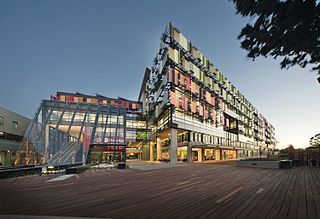| Company type | Subsidiary of Westpac |
|---|---|
| Industry | Finance and Insurance |
| Founded | 1989 |
| Defunct | 2004 |
| Fate | acquired by WBC |
| Headquarters | Melbourne, Australia |
Area served | Victoria, Australia |
| Products | Personal Banking, Business Banking and Insurance |
The Bank of Melbourne is a financial institution based in Melbourne, Australia, established in 1989 and taken over by the Westpac Banking Corporation (Westpac) in 1997. In 2004, Westpac rebranded the Bank of Melbourne branches as Westpac branches. In 2011, Westpac resurrected the brand after rebranding its purchase of Bank of St George in Melbourne specifically and possibly in response to its initial closing of the brand.
The Bank of Melbourne was established in July 1989, following the granting of a banking licence to the RESI Statewide Building Society, with a listing on the Australian Securities Exchange following on 13 July 1989. The first chairman of the bank was Christopher Stewart, who chose Australian actor Jack Thompson to head the bank's TV advertising campaign, which ran for a decade. [1]
The bank focused operations on retail banking, with a branch network and operations focused on the state of Victoria. As a former building society, the bank was also heavily involved in lending in the residential property market. [2] In 1996 the bank acquired the Victorian business of Challenge Bank from Westpac for A$659.7 million, making the Bank of Melbourne the fourth largest regional bank, and the eighth largest of all listed banks in Australia. [2] By this time the Bank of Melbourne also held 9.6% of the Victorian lending market, 11.6% of the Victorian deposit market, and operated a network of 125 branches, predominantly in Melbourne. [2]
On 3 April 1997, Westpac made a $1.43 billion bid to acquire the Bank of Melbourne. At the time, Westpac had a branch network almost twice as large in Victoria as the Bank of Melbourne (212 branches), but a smaller share of the local lending and deposit markets (8.6% and 9.1% respectively). [2]
The proposal required the approval of the Australian Competition & Consumer Commission, the Reserve Bank of Australia and the Treasurer of Australia; these being given by July 1997. On 29 September 1997 a vote was held for ordinary Bank of Melbourne shareholders to approve the proposal, with holders of over 96% of the shares approving the takeover. [2] Westpac retained the rights to the Bank of Melbourne name and logos, and operated in Victoria under the Bank of Melbourne brand until January 2004, when Westpac moved all operations to a single national brand name. [1]
In 2009, speculation suggested Westpac was to relaunch the brand for a new internet-based deposit business, [3] but with no resulting action.
In July 2011, the relaunched Bank of Melbourne commenced operations as a subsidiary of Westpac.

State Bank of India (SBI) is an Indian multinational public sector bank and financial services statutory body headquartered in Mumbai, Maharashtra. SBI is the 48th largest bank in the world by total assets and ranked 221st in the Fortune Global 500 list of the world's biggest corporations of 2020, being the only Indian bank on the list. It is a public sector bank and the largest bank in India with a 23% market share by assets and a 25% share of the total loan and deposits market. It is also the tenth largest employer in India with nearly 250,000 employees. On 14 September 2022, State Bank of India became the third lender and seventh Indian company to cross the ₹ 5-trillion market capitalisation on the Indian stock exchanges for the first time. The Reserve Bank of India (RBI) has identified the SBI, HDFC Bank, and ICICI Bank as Domestic Systemically Important Banks (D-SIBs), which are often referred to as banks that are “too big to fail”.

The Commonwealth Bank of Australia (CBA), or CommBank, is an Australian multinational bank with businesses across New Zealand, Asia, the United States, and the United Kingdom. It provides a variety of financial services, including retail, business and institutional banking, funds management, superannuation, insurance, investment, and broking services. The Commonwealth Bank is the largest Australian listed company on the Australian Securities Exchange as of August 2015, with brands including Bankwest, Colonial First State Investments, ASB Bank, Commonwealth Securities (CommSec) and Commonwealth Insurance (CommInsure). Its former constituent parts were the Commonwealth Trading Bank of Australia, the Commonwealth Savings Bank of Australia, and the Commonwealth Development Bank.

Bendigo and Adelaide Bank, is an Australian financial institution, operating primarily in retail banking. The company was formed by the merger of Bendigo Bank and Adelaide Bank in November 2007.

The Bank of Queensland (BOQ), formerly known as the Brisbane Permanent Benefit Building and Investment Society (BPBBIS) between 1874–1970, is an Australian retail bank with headquarters in Brisbane, Queensland. The bank is one of the oldest financial institutions in Queensland, having begun as a building society. It now has 111 owner-managed branches throughout Australia, including thirty-six corporate branches and third-party intermediaries. They also have over 2,300 ATMs.

BankSA, formerly known as the Bank of South Australia, the State Bank of South Australia and the Savings Bank of South Australia is the largest bank in South Australia. It is a subsidiary of Westpac.
GE Capital is the financial services division of General Electric.

The Australia and New Zealand Banking Group Limited (ANZ) is a multinational banking and financial services company headquartered in Melbourne, Victoria, Australia. It is Australia's second-largest bank by assets and fourth-largest bank by market capitalisation.
St.George Bank is an Australian bank with its headquarters in Sydney. Since a 2008 merger, the bank has been part of Westpac, having previously been an independent legal entity. In 2010, St.George was deregistered as a company and ceased to be a standalone authorised deposit-taking institution.
Banking in Australia is dominated by four major banks: Commonwealth Bank, Westpac, Australia & New Zealand Banking Group and National Australia Bank. There are several smaller banks with a presence throughout the country which includes Bendigo and Adelaide Bank, Suncorp Bank, and a large number of other financial institutions, such as credit unions, building societies and mutual banks, which provide limited banking-type services and are described as authorised deposit-taking institutions (ADIs). Many large foreign banks have a presence, but few have a retail banking presence. The central bank is the Reserve Bank of Australia (RBA). The Australian government’s Financial Claims Scheme (FCS) guarantees deposits up to $250,000 per account-holder per ADI in the event of the ADI failing.

National City Corporation was a regional bank holding company based in Cleveland, Ohio, founded in 1845; it was once one of the ten largest banks in America in terms of deposits, mortgages and home equity lines of credit. Subsidiary National City Mortgage is credited for doing the first mortgage in America. The company operated through an extensive banking network primarily in Ohio, Illinois, Indiana, Kentucky, Michigan, Missouri, Pennsylvania, Florida, and Wisconsin, and also served customers in selected markets nationally. Its core businesses included commercial and retail banking, mortgage financing and servicing, consumer finance, and asset management. The bank reached out to customers primarily through mass advertising and offered comprehensive banking services online. In its last years, the company was commonly known in the media by the abbreviated NatCity, with its investment banking arm even bearing the official name NatCity Investments.

BDO Unibank, Inc., commonly known as Banco de Oro (BDO), is a Philippine banking company based in Mandaluyong. In terms of total assets, the firm is the largest bank in the Philippines and 15th largest in Southeast Asia as of March 31, 2016. BDO Unibank is also a member of SM Group. It is also the largest bank in the country by market capitalization.
Gail Kelly is a South African-born Australian businesswoman. In 2002, she became the first female CEO of a major Australian bank or top 15 company and in 2005 was the highest paid woman in an Australian corporation. She is the former chief executive officer (CEO) of Westpac, a role she held from 2008 to 2015. In 2010 Kelly was named 8th most powerful woman in the world by Forbes and as of 2014, she is listed in 56th place.
Suncorp Group Limited is an Australian finance, insurance, and banking corporation based in Brisbane, Queensland, Australia. It is one of Australia's mid-size banks and its largest general insurance group, formed on 1 December 1996 by the merger of Suncorp, Metway Bank and the Queensland Industry Development Corporation (QIDC).
Founded in 1921 as Australian Guarantee Company to initially provide finance for purchasers of smaller household items, it progressed into financing motor vehicles and was renamed as Australian Guarantee Corporation (AGC) in 1925. AGC was Australia's oldest national finance company offering a range of finance, investment and insurance products and were market leaders in equipment finance, cashflow finance, motor vehicle and personal finance.
The Bank of Melbourne is a financial institution operating in Victoria, Australia. A subsidiary of Westpac, it commenced operations on 25 July 2011.
BSP Financial Group Limited (BSP) is the largest bank in Papua New Guinea, with 121 branches throughout the country and in 7 countries. BSP currently services over 650,000 business banking customers throughout the Pacific. As at 31 December 2022, BSP had total assets valued at K33.9 billion. Bank South Pacific is listed on the PNG Exchange Markets (PNGX) and, as of 25 May 2021, the Australian Securities Exchange (ASX).
The four pillars policy is an Australian Government policy to maintain the separation of the four largest banks in Australia by rejecting any merger or acquisition between the four major banks. The policy, rather than formal regulation, first articulated in 1990, reflects the competitive concerns of more concentration as well as the broad political unpopularity of further bank mergers. A number of economically liberalist commentators have argued that the "four pillars" policy is built upon economic fallacies and works against Australia's better interests.

Westpac Banking Corporation, known simply as Westpac, is an Australian multinational banking and financial services company headquartered at Westpac Place in Sydney, New South Wales.

Wachovia was a diversified financial services company based in Charlotte, North Carolina. Before its acquisition by Wells Fargo and Company in 2008, Wachovia was the fourth-largest bank holding company in the United States, based on total assets. Wachovia provided a broad range of banking, asset management, wealth management, and corporate and investment banking products and services. At its height, it was one of the largest providers of financial services in the United States, operating financial centers in 21 states and Washington, D.C., with locations from Connecticut to Florida and west to California. Wachovia provided global services through more than 40 offices around the world.
Greater Bank is an Australian customer-owned bank and now a brand of Newcastle Greater Mutual Group, an organisation formed through the merger between Greater Bank and Newcastle Permanent Building Society.